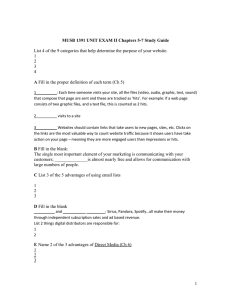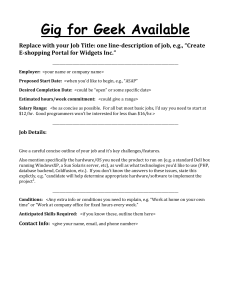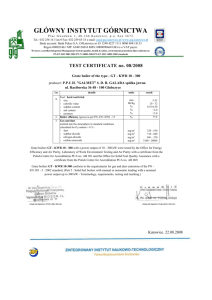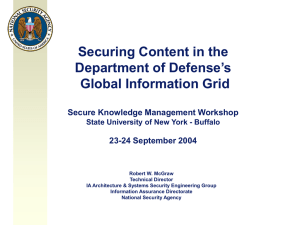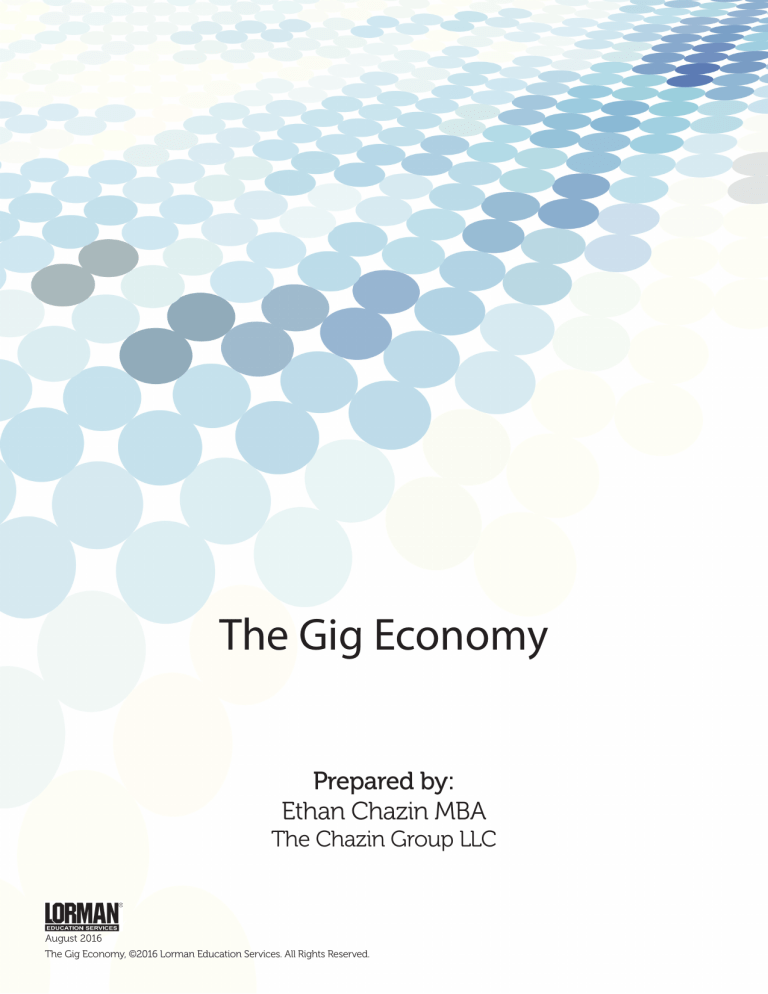
The Gig Economy Prepared by: Ethan Chazin MBA The Chazin Group LLC August 2016 The Gig Economy, ©2016 Lorman Education Services. All Rights Reserved. INTRODUCING Lorman's New Approach to Continuing Education ALL-ACCESS PASS The All-Access Pass grants you UNLIMITED access to Lorman’s ever-growing library of training resources: þ þ þ þ þ þ þ þ Unlimited Live Webinars - 120 live webinars added every month Unlimited OnDemand and MP3 Downloads - Over 1,500 courses available Videos - More than 700 available Slide Decks - More than 1700 available White Papers Reports Articles ... and much more! Join the thousands of other pass-holders that have already trusted us for their professional development by choosing the All-Access Pass. Get Your All-Access Pass Today! SAVE 20% Learn more: www.lorman.com/pass/?s=special20 Use Discount Code Q7014393 and Priority Code 18536 to receive the 20% AAP discount. *Discount cannot be combined with any other discounts. The Gig Economy Prepared by: Ethan Chazin MBA The Chazin Group LLC The Gig economy and the alternative workers who love/hate it. America, the freelance nation. Convenience at the risk of indentured servitude? When I was in High School and College, I worked many temporary jobs through staffing agencies. Then early in my professional career, I worked as a recruiter for a national employment agency in Washington, DC. Throughout my career in Corporate America I worked with placement agencies and recruiters. Now as a career coach, I have spent the past 6 years working with thousands of job seekers. So I am extremely familiar with our 21st Century “Gig” economy, which is also referred to as the sharing, collaborative, peer-to-peer, on-demand, or gift economy. But what is the “gig” economy? Independent workers/freelancers select temporary jobs (projects) to work from anywhere, and employers get to select best workers for specific projects. To understand the transforming role of work in America, it will help to understand why our American workforce is becoming a truly alternative workforce and gig employment is growing exponentially? Financial pressure is being constantly exerted on organization to reduce costs (staff) and the entrance of the Millennial generation, will represent 4 of 5 workers by 2020. Companies realize significant headcount reductions by using freelancers by saving on office space, benefits, and employee training. Temporary positions are common and organizations contract with independent workers for short term engagement projects. Our economy is becoming project work driven to meet peak production periods. Workers must become mini-businesses to find work (clients.) The attraction of flexible work arrangements. The argument most often made for workers benefitting from the option of working gigs is as follows: you are afforded greater work-life balance as people can choose what they want to do, how long they choose to do it, and when/where they choose to work. But there are many drawbacks of committing to work on gigs in lieu of full-time employment. For starters, there is absolutely no economic security, no predictability to work or guarantee of employment, and no power of workers to receive a fair share of profit. A workforce with no safety net, assurances, or power when taken to the extreme. Key drivers fueling the gig economy growth. There are a number of factors that have driven the rise of the gig economy, namely: Post World War II Japanese kaizen, 6-Sigma, lean manufacturing driven by constant process improvement, automation, and… A commensurate American (car) manufacturing reaction to Japanese and German import threats leading to significant worker cost containment/reduction in the 1980s by leveraging employee outsourcing, off-shoring by sourcing cheaper labor from third world markets. The digital age has facilitated a mobile workforce. Smartphone and mobile technology, that enables workers to work from anywhere any time. A shifting cultural and business climate Automation of work flow processes including robotics have led to a significant reduction in the requirement for actual employees. There’s an app for that: constant increases in technology solutions automate workflows, leading to a reduction in the need for workers. A proliferating independent workforce: From a JobVite annual survey, 19% of American adults who responded said they held gig-type jobs. Approximately 54 million Americans claimed to have participated in some type of independent work in 2015. 1 in 3 Americans can be classified as a freelancer. Further, approximately 1 in 12 US households – 10 million people rely on independent work for more than half of their income. The proliferation in alternative work is not a strictly American phenomenon. Half of the UK’s working population will be self-employed in the next 5 years, and the European Union saw a 45% increase in the number of independent workers from 2012-2013. A study conducted by Intuit found that by 2020, 40% of American workers will be independent contractors. A poll by Time, Burston Marsteller, and the Aspen Institute found that 45 million Americans have offered goods and services in this new work model. More than 1/3 made 40% of their income in this new contract economy and 44% of To wit…sharing/gig economy firms are popping up everywhere. AirBNB, Uber, Lfyte, Fiverr, TaskRabbitt, Upwork, Zirtual, Parcel, Hello Alfred, Love Home Swap, Etsy, One Fine Stay, Amazon’s Mechanical Turk…gig economy players are everywhere. A Perma-Temp New Work World Order? A fundamental question that begs asking is: “What does it mean to be an employee in the gig, tech-enabled, and service-driven 21st century American economy? Are we talking about an “on-demand” many serving the privileged few? In other words, is an economy based on an ever-growing army of contract workers good or bad for employees? The answer is not so simple, and depends on what kind of worker we’re talking about. From a study conducted by Rand in 2015 of 4,000 workers, nearly all new jobs growth in America between 2005 and 2015 can be attributed to alternate work. The research uncovered showed that 84% of independent workers want to work for themselves, yet 80% are concerned about the volatility of their income and the lack of benefits they receive. However, 77% of America’s 16 million American temporary workers would prefer full-time jobs. Temporary workers are afforded more legal protections, but they make less per hour then permanent employees. They often do not receive sick days, vacation, insurance, retirement plan, and often little in the way of safety training. The ugly side of contract work with so many intermediary providers. The recession has forced millions of Americans into lower paying jobs; The National Employment Law Project says there are 1.2 million fewer jobs in the midto-high wage industries than before the Recession and 2.3 million more jobs in lower wage sectors; The gig economy is a STOP-GAP solution for workers who cannot make ends meet in a weak labor market. Organizational loop holes to avoid labor laws. When taken to the extreme, organizations can and have intentionally misclassified workers in order to significantly lower worker pay rates which has led to many class action lawsuits. In response, some companies have responded by moving away from contract workers in order to avoid such lawsuits. The challenge with traditional employment was, there were only two “buckets” of worker. Fulltime employees and contractors. Given the lines of worker have blurred in the gig economy, the time has come for a new classification of worker, a third “Other” category requiring a anew legal classification of intermediaries. Perhaps we call this new third option of employee an independent contractor and afford them rights along the lines of permanent employees. According to U.S. Labor Dept. Wage and Hour Division Head David Weil, the American labor department has to play “catch up” by offering more buckets of employee category afforded certain protections. Without such intervention, we can continue to see a more fractured workplace in which companies wash their hands of labor laws by engaging contract workers and take the approach: “Not our employees…not our problem.” Elizabeth Warren has proposed possible solutions to the pitfalls inherent in a gig economy: State run portable insurance plans or contract workers/freelancers run by a union or other organization and contracted invested management to the private sector. Expand social security to include temporary employees. Offer healthcare benefits to temporary employees through expanded Medicaid and health care exchanges. One option is to increase regulation and clarify laws around part-time work. Provide universal right for contract workers to organize. In the meantime, the Obama administration has been telling us there has been a steady rise in America’s post-recession employment figures. But the research actually shows that from 2005- 2015 total employment increased by 9.1 million jobs with gig-based jobs increasing by 9.4 million according to the U.S. Dept. of Labor. In a Freelancers Union 2015 study entitled: “Freelancing in America 2015” revealed that 54 million U.S. workers do at least some freelance work and represent approximately one third of the U.S. work force. According to Freelancers Union Founder Sarah Horowitz “freelancing is the new normal” of work in America. A workforce without rights or power. So why does this matter (esp. to Millennials) and what are the long-term implications for workers? According to Robert Reich, there are many concerns about how the changing nature of work will adversely affect employees who are forced to exist relying on “on-demand work.” The change in work from full-time to alternative gig shifts all economic risks onto the worker. It also eliminates all labor protections for employees such as minimum wage, O/T pay, medical leave, and worker safety protections. It even weds employer-financed insurance like social security workers compensation, unemployment benefits, and employer-provided health insurance. Developing a more equitable worker-employer contract We are at the point where the idea of work, employee, and employee-employer contract need to be revisited to reflect our transforming workplace. Some solutions to consider as we move forward: A blended workforce that maximizes full-time, alternative and hybrid worker options. Rely more on your organization’s existing incumbent workforce for recruiting new workers. Offer more benefits to alternative workers. Reimagine the role of a full-time employee and structure full-time work differently. For additional information: Ethan L. Chazin, MBA The Chazin Group LLC Ethan@TheChazinGroup.com TEL: 201.683.3399 | CELL: 917.23.5571 www.TheChazinGroup.com
